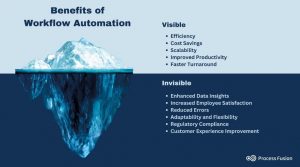
In a fast-paced digital landscape, where businesses are constantly seeking ways to optimize their operations, automation is no longer unfamiliar. However, what sets this exploration apart is our focus on uncovering the “unseen” benefits of workflow automation– those often hidden beneath the surface, waiting to be recognized and harnessed.

In this blog, we’ll open the doors to a world where an effective workflow isn’t just about efficiency; it’s a catalyst for transformation. We’ll venture beyond the expected to reveal the unexpected, discussing the six distinct angles where automation can revolutionize your workflow.
From cost savings and work efficiency to work-life balance and mental health, our journey will leave no stone unturned.
Cost Savings and Efficiency
Let’s begin our journey by unravelling the most conventional yet undeniably vital aspect of workflow automation: cost savings and efficiency. In a business landscape driven by the pursuit of profitability, automation has traditionally outshone in maximizing returns.
Automation’s power to reduce errors, streamline processes, and enhance operational efficiency is well-documented. Tasks that once required significant time and manpower are now executed with precision and speed, all thanks to the magic of automation.
McKinsey Global Institute’s recent report reveals a staggering insight: businesses can achieve up to a 20% reduction in operating costs through workflow automation. That’s not just a number; it’s a game-changer. Consider what a 20% reduction in operating costs could mean for your bottom line. It’s a pathway to sustainable growth.
But let’s not stop there. The benefits go beyond the obvious. Reduced errors also mean fewer costly mistakes and less time spent correcting them. Increased operational efficiency will lead to shorter delivery times, happier customers, and a competitive edge in the market.
With automation, cost savings isn’t just about money – it’s about time, resources, and the freedom to focus on what truly matters.
Innovation and Creativity
Innovation is the lifeblood of any successful business. It’s the driving force that propels companies into the future. But how can automation, often associated with routine and repetitive tasks, ignite the spark of innovation?
According to Harvard Business Review’s research, companies with streamlined workflows are a staggering 60% more likely to foster innovation among employees.
Automation does heavy lifting, taking care of mundane tasks and freeing up valuable time for employees to focus on creative problem-solving. When your workforce is liberated from the routine, they can innovate, think critically, and explore new possibilities.
Employee Productivity and Job Satisfaction
Another widespread concern many workers share is the fear that automation would replace jobs. This perception, however, is only one side of the coin. The other side reveals a story of empowerment and enhanced job satisfaction.
According to Gallup’s research, engaged employees are 21% more productive, underscoring how automation can catalyze improved job satisfaction. This newfound sense of purpose reinvigorates their work, reducing burnout and elevating overall job satisfaction.
By embracing automation to complement human capabilities, businesses empower their workforce to become more efficient, effective and engaged. Rather than being displaced, employees become the driving force behind the innovations that shape the company’s future.
Sustainability and Environmental Impact
It’s time to challenge the commonly held belief that automation harms the environment, for the reality is quite the opposite.
Automation paves the way for a paperless office in a world where deforestation and paper waste are environmental concerns. Digital documents and automated processes mean fewer trees cut down and less paper filling our landfills.
But the environmental benefits extend far beyond just paper. Energy efficiency is another crucial factor. Traditional, manual workflows often rely on energy-consuming processes. In contrast, automation can streamline operations and lead to reduced energy usage. That’s not just good for the planet but also for your bottom line.
Embracing automation isn’t just about enhancing efficiency. An optimized workflow can be a powerful ally in the fight for a greener, more sustainable world.
Enhancing Customer Experiences
Automation streamlines internal tasks and enhances external experiences, especially for your valued customers.
According to Zendesk’s data, businesses implementing workflow automation experienced a remarkable 25% increase in customer satisfaction scores.
So, what’s driving this boost in customer satisfaction?
Automation ensures swift and accurate responses, shorter wait times, and more personalized interactions. It’s a recipe for happier, more loyal customers.
Moreover, automation allows you to anticipate customer needs, track preferences, and provide a more tailored experience. When your customers feel heard and valued, they’re more likely to become repeat buyers and brand advocates.
Automation isn’t just about enhancing internal processes; it’s about elevating the entire customer journey. It’s about creating a positive and lasting impression, forging strong relationships, and ensuring that your customers return and recommend your business to others.
Consider this: when tedious, time-consuming tasks no longer bog down employees, they become engines of invention. They can brainstorm, experiment, and propose novel ideas, knowing that automation has already addressed the routine. This newfound creativity isn’t just a perk; it’s a competitive advantage.
Work-Life Balance and Mental Health
It’s time to challenge the prevailing notion that automation inevitably leads to a workaholic culture.
In a world where workplace stress is growing, automation can be a much-needed balm. When repetitive, time-consuming tasks are automated, employees are no longer shackled to their desks. They have the freedom to maintain a healthier work-life balance. They can leave the office on time, disconnect during weekends, and enjoy vacations without the constant worry of work piling up.
This balance is crucial both for mental health and productivity. In a balanced environment, employees thrive, fostering a more engaged and motivated workforce.
So, automation stands not as the adversary of work-life balance but as a strong ally in its pursuit.
Conclusion
Workflow automation is a multifaceted powerhouse that elevates how businesses operate. Beyond streamlining processes and reducing costs, it improves job satisfaction, promotes environmental responsibility, enhances customer experiences, sparks innovation, and fosters well-being. It’s a holistic transformation that invites us to look beyond the surface and embrace automation’s “unseen” benefits.







